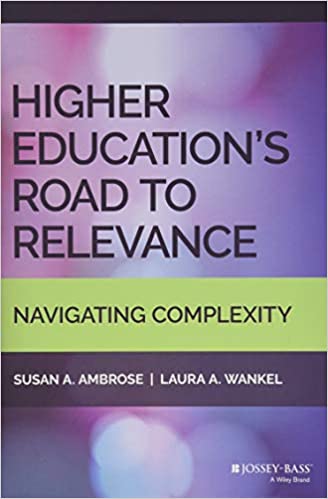You have /5 articles left.
Sign up for a free account or log in.
 Higher Education's Road to Relevance: Navigating Complexity by Susan A. Ambrose and Laura A. Wankel
Higher Education's Road to Relevance: Navigating Complexity by Susan A. Ambrose and Laura A. Wankel
Published in January 2020
In Higher Education's Road to Relevance, Susan Ambrose and Laura Wankel set themselves the task of creating a road map to assist colleges and universities in navigating an increasingly complex and challenging postsecondary environment.
Looking back to January 2020, when the book was published, it seemed to all of us in higher education that we had enough on our collective plates.
The realities of demographic change, public disinvestment, rising costs, political polarization, economic inequality, climate change and new competitors seemed like quite enough for those of us in academia to try to manage -- thank you very much.
And then the pandemic hit.
For the reader of Higher Education's Road to Relevance, the good news is that none of the structural challenges that Ambrose and Wankel identify have gone away. If anything, the challenges of rising institutional costs and declining revenues have only been heightened by the pandemic.
Where this book excels is in situating the roles that colleges and universities play within the context of a rapidly changing economic and social environment.
Road to Relevance is strongest in examining the mismatch between the prevailing design of the higher education system and the demands of both students and prospective employers.
Ambrose and Wankel work to unpack how postsecondary credentials have become so expensive (driving student debt). At the same time, many of higher education's outcomes leave much to be desired. These outcomes range from stubbornly low graduation rates (high attrition) to graduates who lack the skills and perspective necessary to move into higher-paying career roles (and pay off all that student debt).
Ambrose and Wankel are after colleges and universities to shift away from cautious incrementalism and build a culture that embraces institutional risks.
Minor changes will likely be inadequate in the face of broader demographic and economic forces. The time has come for institutionwide commitments to innovation through experimentation, rapid prototyping and the launch of minimally viable educational products.
There are many good ideas and many examples of college and university innovations in Higher Education's Road to Relevance. Perhaps too many.
This broad but less deep approach to analyzing higher ed change is understandable. Institutional reforms will be highly context-dependent. Strategies that work well at one school will be inappropriate for others.
There is likely little disagreement that higher education needs to become more flexible and less expensive. We all want higher-quality educational outcomes, lower attrition rates and for our graduates to get terrific jobs.
While almost all of us believe in the power of higher education to transform lives and are proud of the resilience and mission-driven success of the colleges and universities where we work, few of us would argue that nothing needs to change.
Higher Education's Road to Relevance does an excellent job of framing the overall challenges faced by our sector. And the book offers many great examples of innovations that colleges and universities have pursued to make nonincremental improvements.
The next step will be to focus this change agenda more narrowly on specific institution types. Perhaps the next book that Ambrose and Wankel write will try to apply the lessons of Road to Relevance to particular kinds of institutions, like tuition-dependent liberal arts colleges or research-intensive universities.
A springboard from Road to Relevance would be to have a conversation about the enabling (and inhibiting) forces within colleges that enable (or impede) the sort of institutional innovations discussed in the book.
Higher Education's Road to Relevance is another excellent read for every student of higher education. I hope that it finds the wide audience that the book deserves.
What are you reading?








